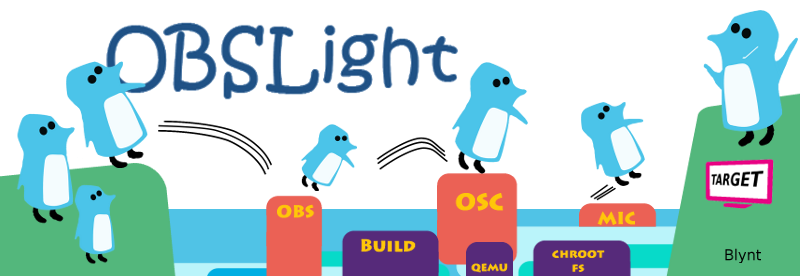openSUSE:OBS Light Fakeobs Manual of grabgbs
Vendor: OBS Light
Developer: OBS Light Team
License: GPLv2
Web: OBS Light on Gitorious
OBS Light Fakeobs: Manual of grabgbs command
obslight-fakeobs-grabgbs - Grab from a GBS output of an OBS server one or more subprojects ino the fakeobs database.
SYNOPSYS
obslight-fakeobs grabgbs [options] -n|--name <project-name> <uri>
or
obslight-fakeobs fromgbs [options] -n|--name <project-name> <uri>
DESCRIPTION
Import to the the *fakeobs* database the project given by <uri>.
The primary goal of that option of obslight-fakeobs is to import the GBS output of the OBS of Tizen.
The <uri> should point to a download directory of *Tizen*. It must look something like [SCHEME:]//download.tizen.org/SUBPATH. Where:
- SCHEME if present is in 'rsync', 'https', 'http'.
If SCHEME isn't given, the above methods wil be tried in the given order: 'rsync' then 'https' and finally 'http'.
- SUBPATH points to a directory that MUST contain a subdirectory
named 'builddata' that MUST contain the file 'build.xml'.
A such <uri> is the base uri of a Tizen build for GBS. It contains several subprojects. At least 2 subprojects: tizen-base and tizen-main. But more can be found. Every subproject is imported to the *fakeobs* database as subprojects of the project named <project-name> given with the MANDATORY option --name <project-name>.
Because fakeobs should know the dependencies betwen the imported subprojects, the option --order allows to give the order of dependencies between the subpojects.
CAUTION: An OBS builds for one or more architectures. Architectures are also named targets by fakeobs. The imported targets must be explicitely given by the option --target. If targets aren't given, nothing will be imported.
The targeted builds are built for one or several processors also designed as 'arch'. The option --arch allow to tell what arch is needed.
For Tizen, it is generally a good idea to check the download repository using a web navigator. The main entry point is https://download.tizen.org/ .
OPTIONS
- -n, --name <project-name>
This option is MANDATORY. The grab creates the project of name <project-name> in the database of fakeobs.
- -t, --target <target-name>
Tells that the target of name <target-name> is to grab. Many target can be set. Any not listed target is left out, so at least one target have to be set.
- -a, --arch <arch-name>
Tells that the arch of name <arch-name> is to grab. Many target can be set. If no arch is set then all available archs are grabbed. You can also use --arch '*' to grab all the available archs.
- -o, --order <subproject-name>
Give a the <subproject-name> for ordering subprojects dependencies. A given subproject will be made dependent of all the subprojects previously given using the --order option.
- -v, --verbose
Display more information messages.
- -f, --force
Don't stop if the project already exists in the database of fakeobs.
- -k, --rsynckeep
Don't remove the internally synchronized files. Use that option for example on a lastest built if you wanted to further update it using the --force option.
EXAMPLES
obslight-fakeobs grabgbs -t ia32 -a i586 -a i686 -o tizen-base -o tizen-main -n Tizen:r2.0a http://download.tizen.org/releases/2.0alpha/daily/latest/
Using the above command, you grab from //download.tizen.org/releases/2.0alpha (that
doesn't offer rsync facility) all the subprojects, making the subproject tizen-main
depend of the subproject tizen-base.
Because rsync is active for snapshots, the following command is valid.
obslight-fakeobs grabgbs -t ia32 -o tizen-base -o tizen-main -n Tizen:2.0 -k -f rsync://download.tizen.org/snapshots/2.0alpha/common/latest/
That command can be used to track the latest snapshot.
KNOWN ISSUE
The contents of the ':full' subdirectories can't be grabed but must be guessed. It actually works for 'i686' and 'i586' archs, not for arm.
